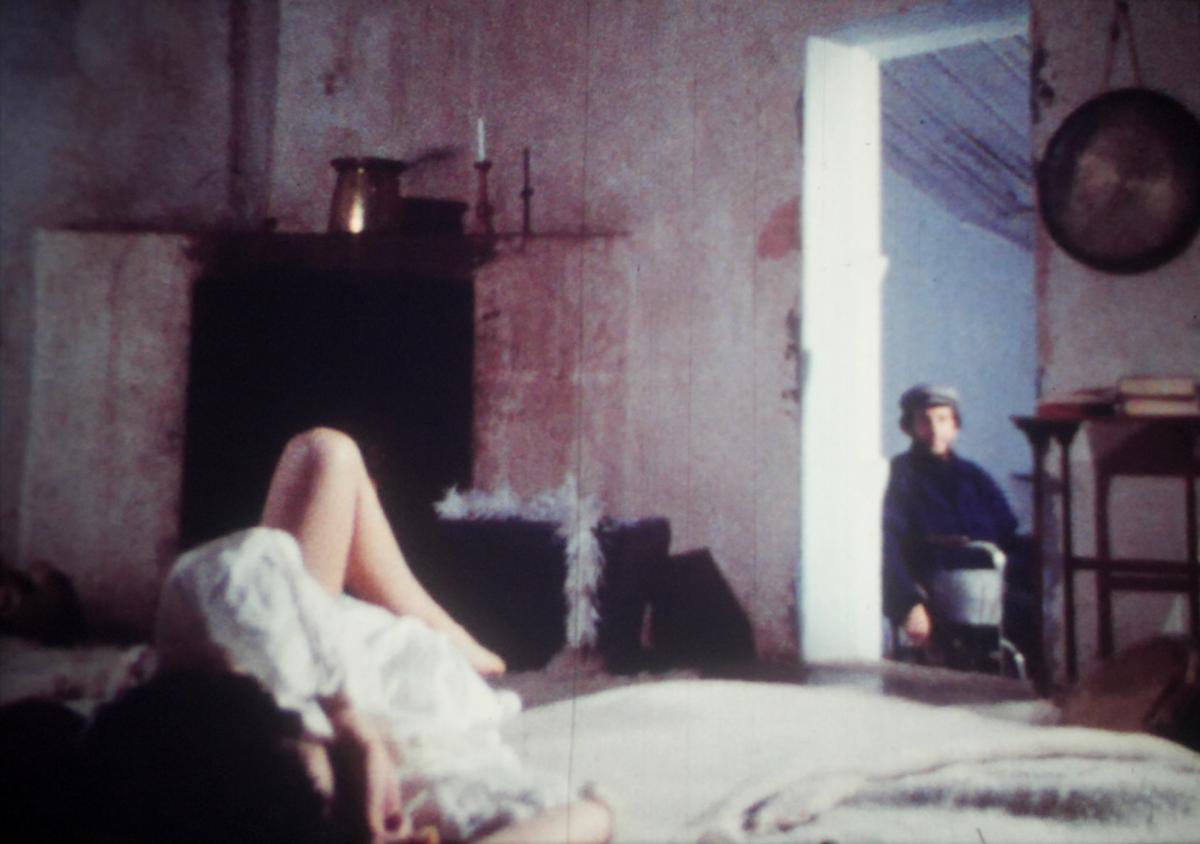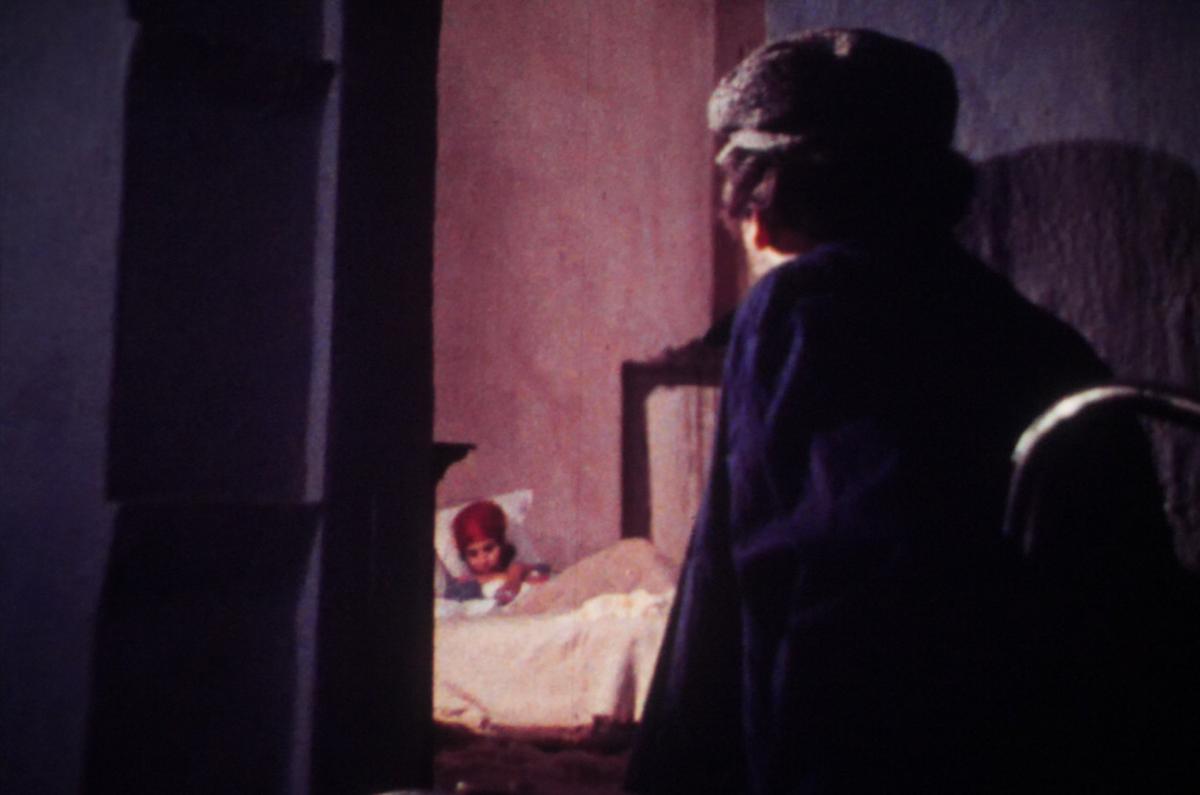A Woman’s Gaze

One night in December 1976, in a farm rented from some peasant farmers 70 kilometres from Algiers, with a team of seventeen technicians and two actors, I was shooting an interior night scene – a man looking at his sleeping wife. A banal situation? No particular action... except for the duration of the look (a minute and a half), or rather of the double look – myself, the technicians, and later the film audience, looking at the man, the Other, looking at an Algerian woman lying heedlessly asleep, like a Venus in an Italian Renaissance painting. It was as if all art (at that time Arab cinema could, objectively, be said to be at a stage of development similar to that of Florentine or Venetian painting of the Quattrocento) had to begin by going through this original experience: how the Other looks at a woman in an unguarded moment and how, in turn, we look at him looking at her.
In the film, The Nouba of the Women of Mount Chenoua, the woman is lying on the marital bed, her hair bound up in a red scarf; only the pure lines of her face are visible. I had worked out the décor down to the last detail – the silky glimmer of the bedclothes and the pillows contrasting with the rough white-washed walls, the carpets on the floor, and wool, lots of wool all around. Enveloped in the wide bed, the sleeping woman seems passive, serene. Then, from her few disordered movements, we gradually sense the beginnings of a struggle against a night-mare – the memories, as we will later learn, of a wartime past.
Let us return to the gaze of the Other: the man immobile in the doorway of the bedroom looking at his wife? Will he join her on the bed? No. The gaze, here, is certainly a gaze of desire (Would there really be cinema if it wasn’t for the search for desire, explicitly or implicitly, or at least for its preliminaries?), but it is not observed with sufficient insistence to suggest shared pleasure, the promise of intimate union. The Other’s way of looking at the desirable woman, a gaze on which we too are spying, is not the gaze of a voyeur. Slowly and with increasing intensity (a minute and a half can be a very long time), he is, despite himself, contemplating his impotence and the pain of separation. It is a gaze before the desert, a gaze that confronts, that makes more distinct the dividing line between a couple, between the sexes.
I should, perhaps, have indicated earlier that the man is immobilized in a wheelchair which he has propelled along the wall to the open door. Even at a distance, the woman is fascinating. His hand grips the door frame. Behind the camera, I capture the movement of the seated man as he struggles to rise, inch by inch, his face in profile twisted by the effort, and in the background the bed, the sleeping woman with the red kerchief – two masks, one so near, the other so distant. The Other’s gaze at women: long after, I began to wonder if it was really just by chance that I had decided to shoot this interior night scene. At the time I had sought only the pleasure of a pictorial and cinematic composition. Had I not chosen the scene in spite of myself? After all, for me as a writer, as a filmmaker, or simply as an Arab woman, was not the real problem the painful search for an answer to the question as to the nature of the Other’s look at women, in a culture in which, for centuries, the eye had been closely guarded? One eye only existed, the eye of the master of the harem who forbade all visual imagery and invoked religious taboos to reinforce this dominance. The gaze of the Other, unless it is the gaze of a voyeur (an aggressive, invasive gaze), perceives nothing but the image of the woman, a mirage enshrouded in poetry and melancholy.
One could, indeed, summarize Arab cinema today by this issue of the gaze of the Other. Yet it seems relevant to me to enlarge the experience I have just described of this male gaze “before the desert” to include the submission through the gaze, in a not so distant past, of an entire society confronted with colonization: Arab, African or Eastern cultures, controlled, archived, “illustrated” by a dominant gaze. The Other was the Western painter (the painter of battle scenes, then the orientalist painter of fantasias, of caravans, bedouins, dancers, children begging against a background of sand dunes and ruined mosques), and then the traveller-photographer of the years between 1880 and 1900, when the great colonial empires were at the height of their power. This period saw a profusion of postcards, which were despatched in their thousands – pictures of more or less scantily clad “belles fatmas” [“beautiful Fatmas” – a stereotypical postcard image of an Algerian woman] across which, or on the back of which, tourists, soldiers and short-stay residents inscribed their messages with apparent indifference.
Thus, for about a century and a half, as in the days of pagan magic, people were “possessed” – both in the sense of being dominated and of being tricked – by the annexation of their image in an operation in which they took no part. People communicated with each other on pictures of Arabs or Blacks who themselves were excluded from communication. Did they “look” at them? No, they used their image – their apparent difference, in fact – as a pretext for the circulation of ideas, words and banalities without their being even symbolically involved. A pretext-gaze of the absent for the absent: more than ever, the beings thus observed were denied any fundamental identity, as if their difference became a matter of fashion, of folklore, an empty décor. An entire “colonial cinema”, documentaries and fiction films, held sway for decades; once successful, it has today completely disappeared. As if, everywhere at the time, the blind were filming mirages. And then, suddenly, women began to open their eyes and look around them. Women who until then had no right to look, who walked with lowered eyes, their faces, their foreheads, their entire bodies enveloped except for a tiny orifice left so that they could see a few paces ahead. At last they had a right to the world outside, to schooling, to study, to space. They forgot themselves so far as to contemplate the sky, trees, nature, foam on the waves, to observe the city streets and crowds, to look at others – other women, all humanity.
I venture to return to my own modest experience of “elaborate looking” over time, because, for me, the strength of the cinema lies in its scrupulous, meticulous examination of ways of looking, in its way of looking at those who cannot look and of encountering those, whether men or women, who look for the first time. Let us, therefore, go back to the first scene of The Nouba of the Women of Mount Chenoua. A woman is standing with her back to the audience; all that can be seen of her is her hair and the outline of her head against a wall. She rubs her forehead against the stone wall; perhaps, through impatience or helplessness, she has just banged her head against it. It’s possible, since she turns us away, turns me away, the camera-gaze. Yet this is how I chose to show her. She walks on, searching, persisting in her rejection of the audience. Suddenly her voice breaks out, and with it all her inner feeling of revolt:
“I speak, I speak, I speak!” Then silence. “I don’t want anybody to see me,” she says.
And then she adds, and we understand that the man is also there in the room, waiting: “I don’t want you to see me.” Thus, the heroine of the film, who will live out her life before us in the next two hours, begins by proclaiming her refusal to be looked at. Then she turns and faces us, because, above all, she wants to speak, to communicate. Perhaps she is unaware that it is difficult to speak out in front of others, or that to speak into the void and into the silence is even more difficult. Yet her desire to express herself is manifest:
“I speak, I speak, I speak!”
In other words the screen might be no more than a ribbon of darkness, a non-image pierced from time to time by the distant profile of a woman to remind us that the woman is there; only her voice becomes duration, full presence – a word preceded by her shadow. My conclusion is that films made by women – from the Third World as well as from the “Old World” – are an expression of a desire to speak. It is as though “shooting” means for women a new mobility of voice and body, of a body unobserved and therefore unsubordinated, with a rediscovered autonomy and innocence. As a result, the voice takes wings and dances. Only then, eyes open.
At last the Other is seeing with her own eyes. In The Nouba of the Women of Mount Chenoua, the young woman architect who returns to the land of her childhood does indeed begin to speak, and she goes out too, rediscovering old haunts. As she wanders her eyes seek out places, houses, rivers, even those that have run dry, and forests, even those that have been burnt down. She meets other women who look at her in their turn. And through this exchange of looks, often slow, sometimes furtive, or simply blank, with the blankness of waiting, dialogues are opened – concerning the present and the past. And all around, these women among women are accompanied by the pervasive presence of scores of idle, noisy, laughing children and their uncertain bursts of song. As I follow the heroine, I look at the other women. Or rather, I watch her, a young independent woman, savouring her rebirth. I watch her discovering the other women. As she looks at the peasant women her look opens the floodgates of speech, until then firmly closed – women’s talk about the banalities of daily life and about the still vivid past, about the embers of memories still painful despite the balm of forgetfulness. “How can I weep, when I have no tears left?” exclaims an old peasant woman, with a dried up face but a proud bearing. A woman looks at other women. And in that look desire plays no part. The barren gap between human beings disappears, conversations interweave. Returning home as dusk falls, the young woman is enveloped in the warmth of those who have spoken to her. It is as if the voice always preceded the body and the eyes and thus, far from the rapine of voyeurism, in these half-blind fumblings were to be found love, tenderness and recognition.
Can it be simply by chance that most films created by women give as much importance to sound, to music, to the timbre of voices recorded or captured unawares, as they do to the image itself? It is as though the screen had to be approached cautiously and be peopled, if need be, with images seen through a look, even a short-sighted, hazy look, but borne on a full, commanding voice, hard as stone but fragile and rich as the human heart.

Originally published as ‘Un regard de femme’ and (in translated version) ‘Behind the Veil. Women on Both Sides of the Camera’ in Courrier de l’Unesco (October 1989). Republished, in an alternative version, as ‘Regard de l’autre, regard sur l’autre’ in Assia Djebar, Ces voix qui m’assiègent (Paris: Albin Michel, 1999).
Images (1) and (2) from La nouba des femmes du mont Chenoua (Assia Djebar, 1979)

